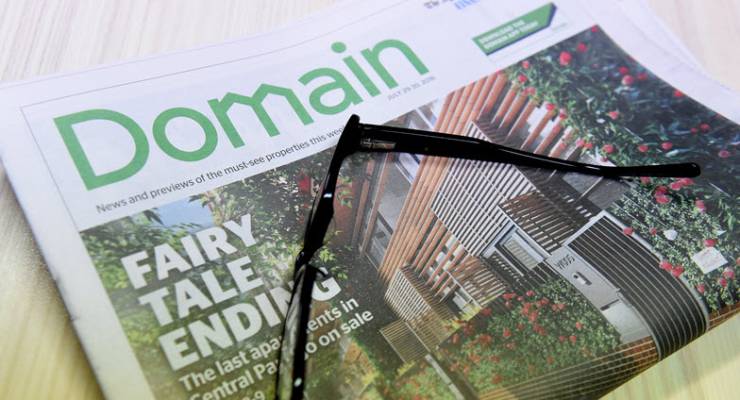
For Fairfax shareholders, after a few false starts and a couple of would-be private equity suitors, the Domain spin-off is finally happening. After the separation, Fairfax shareholders will own 60% of the sort-of independent Domain business. Fairfax claims the main reason for the separation is to unlock “long term shareholder value” because Domain will have a separate valuation. This makes no sense as, in the long term, the market is efficient, and a dollar of earnings is a dollar of earnings. However, the separation will, of course, benefit speculators and profiteers who have pressured the Fairfax board to flip Domain for a quick return because, in the short term, the faster growing business will be graced with a higher-earnings multiple.
But far more interesting than the ham-fisted rationale for the separation, scrounged together by the poor investment banker or lawyer who was tasked with preparing the Scheme Booklet (note: your author has written many such booklet), is Domain’s controversial “Agent Ownership Model”.
But before we continue, first, a quick history lesson.
While Domain was founded in 1996 during the peak of Fairfax’s last rivers-of-gold period, the business achieved significant digital scale and profitability when Antony “The Cat” Catalano returned to Fairfax in 2011. The Cat had once been a Fairfax journalist and senior executive before being made redundant in 2008.
Catalano — who was a former property editor at Fairfax and had extensive real estate agent connections — came up with the idea of a weekly real estate magazine, delivered free to selected post codes. This was the identical model that Crikey owner Eric Beecher used when he successfully created the Melbourne Weekly magazine (the Cat had previously tried to destroy Beecher’s Melbourne Weekly in 2003, but then Fairfax CEO Fred Hilmer instead bought it for $67 million).
By 2009, Catalano was no longer beholden to Fairfax and was now the challenger. His secret weapon was his connection to Melbourne’s most prestigious real estate agents, including Kay & Burton. Catalano would make four key agents founding shareholders of his new business, called Metro Media Publishing. Unlike Beecher’s Melbourne Weekly, Catalano’s business was profitable immediately. Why? Because its agent shareholders immediately funneled clients’ advertising to MMP (and away from Fairfax).
[Fairfax shifts focus to listing Domain on ASX]
Within a couple of years of creating MMP, in 2011, it would be worth around $100 million. First Realestate.com offered him $5 million for a 5% stake, before Fairfax, by then under the leadership of Catalano’s former mentor, Greg Hywood, bought the business for $30 million cash and later, $70 million in shares. Interestingly, News Corp, declined to purchase MMP, allegedly due to the nature of the agent ownership model.
History lesson over, now back to the Agent Ownership Model and why it’s potentially, a really big deal.
Fairfax’s scheme booklet noted that “the Agent Ownership Model (AOM) is a strategic initiative between Domain and the real estate industry which provides participating real estate agencies with the opportunity to share in the value they create through the property marketing process.”
Fairfax then states:
“The AOM provides participating agencies with the opportunity to acquire a shareholding in a private company and the potential to receive dividends, should that company be profitable and declare a dividend. Share capital in the Residential Digital and CRE entities include performance shares. Allocation of performance shares in the relevant AOM entity is determined based on a participating agency’s spend on relevant products during the allocation period.” (Emphasis added.)
And that’s the kicker.
The growth of Domain and the ingenious business model that Catalano created is largely based upon the exploitation by agents of clients’ money.
Why?
Simple. Agents are indirectly paid by Domain for funneling advertising to Domain (that was how Catalano was able to make a profit on his very first edition of the Weekly Review). Even though it’s significantly cheaper for agents to advertise online only (on the Domain or Realestate.com websites), they spend millions of dollars advertising in a relatively barely read magazine that is far harder to attribute. Real estate agents don’t really care how their clients’ monies are spent (so long as it’s not so expensive that clients complain). Therefore, it’s in the agents’ interest to invest in expensive Domain products because they’re essentially getting a kickback (via Domain’s AOM policies, which were spelled out very clearly in its scheme booklet).
[All’s Fairfax in love and bidding war]
This is not exactly breaking news. McGrath Real Estate founder John McGrath noted back in 2015 that Domain’s model may entice agents to make marketing recommendations that were in their own interests, rather than their clients.
But now Domain is separating from Fairfax, though it remains a key plank of their business model. Almost a third of Domain’s revenues still come from print, no doubt partially spurred by the unique Agent Ownership Model.
The question is how long the ACCC will allow Domain to continue with this peculiar business model.
*Adam Schwab is a former lawyer and the author of Pigs at the Trough: Lessons from Australia’s Decade of Corporate Greed, published by John Wiley & Sons in 2010.








Thanks Adam.
Effectively no different to commission based financial advice really.
Conflicted, moi?
If The Age breaks away from Domain entirely, maybe they can be more objective in articles about the housing market.
With the objective being… ha, ha, ha, suckerrrrr!